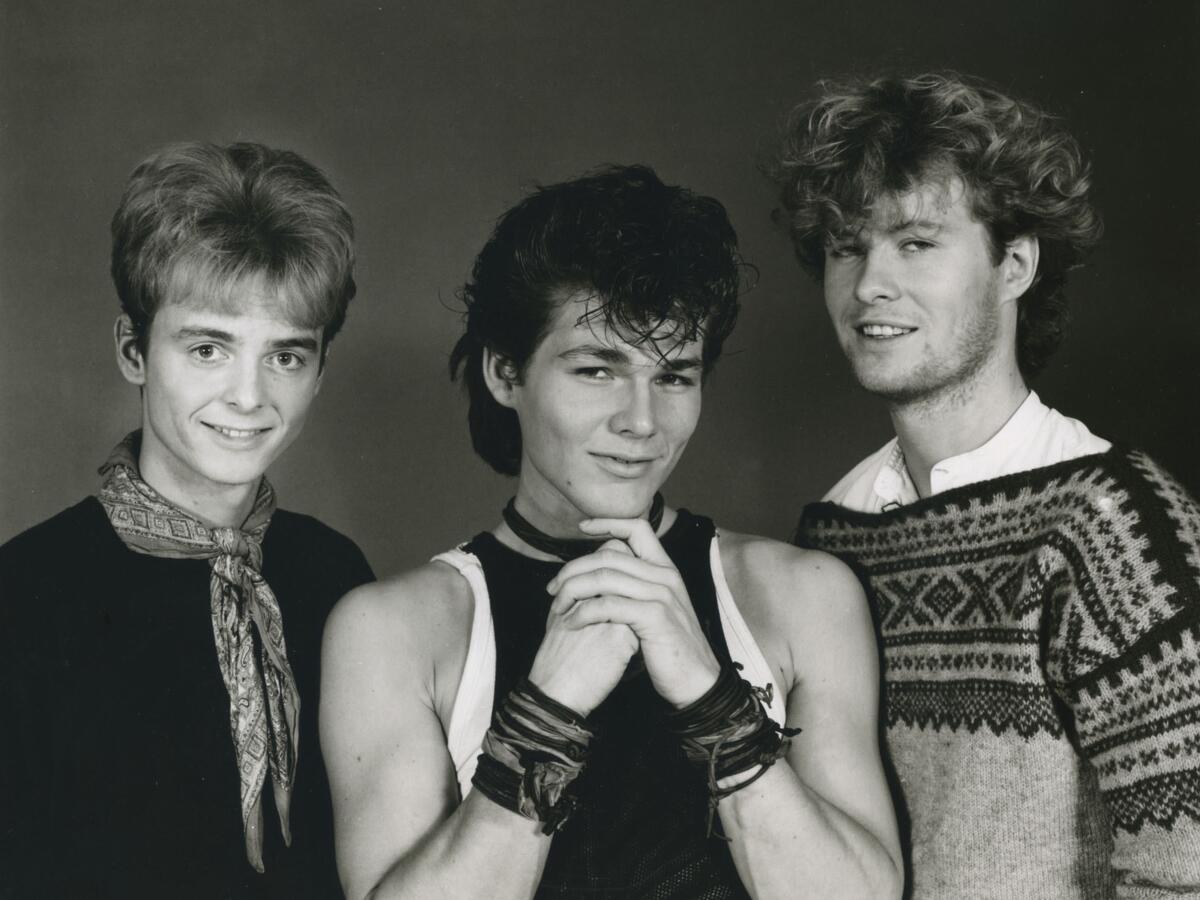‘Taaaake onnn meee!’ The unkillable, oh-so-profitable afterlife of a-ha’s ’80s classic

- Share via
The first time a-ha singer Morten Harket heard the now-famous synthesizer hook in “Take on Me,” a bell rang in his head. He knew the fleet, perky melody would launch him into a noteworthy music career.
In the 34 years since “Take on Me” became the Norwegian trio’s world-conquering hit, it has not only endured but also has been transformed into a meme that crosses generations and centuries.
The ‘80s was a decade of outrageous musical novelties and wonders. Most of the decade’s synth-pop hits are as outdated as a Walkman or have vanished like Blockbuster video, but “Take on Me” has outlasted its peers and even thrived in the streaming era.
The memorable boy-meets-girl-and-is-chased-by-men-with-wrenches animated video, an innovative highlight of early MTV, propelled much of the song’s success. On YouTube, the clip is close to surpassing 1 billion views. It’s not uncommon for new songs to pass that threshold, but to date, only three songs from the entire 20th century have reached that mark: “November Rain” by Guns N’ Roses, “Smells Like Teen Spirit” by Nirvana and Queen’s “Bohemian Rhapsody.” And “Take on Me” still averages 480,000 views per day on YouTube, according to a website spokesperson. Last year, when “Take on Me” enjoyed one of its periodic resurgences as a presence in TV shows and films, the website Quartzy called it “one of the biggest songs of 2018.”
“I don’t know how to relate to it,” Harket says of the approaching milestone. “It’s not an easy thing to get your head around.”

The singer, who turned 60 this month, was ambitious, dreamy but unfocused until late 1979, when, at his former high school in Oslo, he heard Magne Furuholmen and Paul Waaktaar-Savoy playing in a Doors-influenced group called Bridges. They were incredible, he thought, but they were lacking one thing: him.
When the three met, Harket insisted his bandmates prove themselves. “I confronted them and said, ‘Play me something.’” In the basement of the house where Waaktaar-Savoy’s parents lived, Furuholmen went to an old piano and played the song’s hook, which he’d written when he was 15.
“I knew then, ‘That’s it.’ That’s the song that’s gonna make it happen,” says Harket. Though he spotted the hook as a ticket to success, he couldn’t have anticipated how many times the trio would have to rewrite and re-release the song.
Bridges first used the hook in what they called “The Juicy Fruit Song.” (It’s on YouTube.) With Harket, it morphed into a song called “Lesson One,” then changed again into “All’s Well That Ends Well and Moves With the Sun.”
“We couldn’t make the hook fit into a song,” Harket says. Eventually, Waaktaar-Savoy rewrote the lyrics with a new chorus, adding a rising, three-note melody (“Taaaaaake onnnn meeee”) inspired by the famous three-note octave motif of Richard Strauss’ “Thus Spake Zarathustra.”
They got a record deal in England, and “Take on Me” was released in October 1984, selling only 300 copies. A few months later, now remixed, the song flopped again. The world seemed to be saying no to a-ha, but the band had a guardian angel.
Jeff Ayeroff, a legendary Warner Bros. Records executive, was visiting England when a British colleague played him “Take on Me.” It reminded Ayeroff of his favorite singer, Roy Orbison. Then, Ayeroff saw a picture of the group.
“It was like, ‘You’ve got to be kidding. Do people actually look like this?’ Morten Harket was one of the best-looking men in the world,” Ayeroff said a few years ago in an interview for the book “I Want My MTV.” [Full disclosure: I co-wrote this book with Times pop music editor Craig Marks.]
Ayeroff knew a-ha was perfect for the age of music video. So the group recorded the song again, this time with producer Alan Tarney, who made the arrangement more dynamic. Harket’s yearning voice spanned two and a half octaves, culminating in a super-high falsetto E5 that has undone many an overconfident karaoke singer.
In the U.S., the song was released with a humdrum video, and flopped for a third time. Ayeroff still wasn’t ready to give up, so he paired video director Steve Barron with animators Michael Patterson and Candace Reckinger, gave them a lot of money and told them not to come back until they’d made something brilliant.
The video took three months and was worth the wait: The world saw Morten Harket’s heroic cheekbones and swooned. In fall 1985, eight years after Furuholmen wrote the central riff, “Take on Me” went No. 1 in 27 countries.
It’s uncharitable to call a-ha a one-hit wonder (“The Sun Always Shines on TV” hit No. 20 in the U.S. and No. 1 in the U.K.), but the group never equaled the success of “Take on Me.” Band members acknowledge that they didn’t ingratiate themselves with people in the music business. When they were nominated for 11 MTV Video Music Awards in 1986, they skipped the ceremony, and instead played a 2,200-seat Houston theater. (They won eight VMAs that night, including new artist and direction in a video.)

Over the next few years, Barron saw growing frustration in the band. “They always felt a little bit in the shadow of ‘Take on Me,’” he said in “I Want My MTV.” “They wanted to be known as a band with a great body of work, not a band with that one video.”
Part of the song’s appeal lies in its old-fashioned romanticism: An ardent suitor pledges his devotion, in an androgynous voice, to a hesitant partner, and exclaims, “You’re shying away / I’ll be coming for you anyway.” It’s a romance novel in rhyme. And few songs evoke silliness and joy as immediately as “Take on Me” does.
It has been covered in a variety of styles, from Reel Big Fish’s ska rendition to MxPx’s pop-punk to whatever you’d call Metallica’s live version. It’s probably the only song covered by both Coldplay’s Chris Martin and Disney princess Lea Salonga. Pitbull sampled it for his 2013 collaboration with Christina Aguilera, “Feel This Moment.” “I don’t have a strong urge for people to be respectful of the song,” Harket shrugs.
Jim Carrey sang it on David Letterman’s show. In 2008, it was the first Literal Video, a hit YouTube series in which director Dustin McLean replaces a song’s lyrics with new ones that narrate what’s happening in the video. It was parodied in a “Family Guy” episode and in a Volkswagen ad. Chrissy Teigen danced to it on “Lip Sync Battle.” It’s been in “Melrose Place” and “Manhunt: Unabomber,” in “Smallville” and “South Park,” “Supergirl” and “Superstore.” “Stranger Things.” It shows up in “Despicable Me 3,” “Whiskey Tango Foxtrot,” “Ready Player One,” “A Dog’s Purpose,” in “La La Land’s” great pool-party scene and inevitably in “Deadpool 2.” It’s in “Moulin Rouge! The Musical” and in an ad for cottage cheese.
“‘Take on Me’ is the ‘Macarena’ of ‘80s songs,” says Steven Gizicki, the Grammy-nominated music supervisor on “La La Land,” “Fosse/Verdon” and many other projects. “It’s full of energy and fun, and has a spring to it. And the song literally doesn’t say much, so it’s not bogged down by deeper meaning. It feels instinctual, like a song we’ve known all our lives.”

Without knowing the details of a-ha’s various contracts, it’s possible only to estimate the amount of revenue the song has generated.
On YouTube, royalties are based on CPM (cost per thousand), which can range from $1 to $6 for videos. “Typically, for a song that big and viral, you’re looking at a three dollar CPM,” says Jonathan Strauss, founder and chief executive of Create Music Group, a tech company that collects income from streaming platforms on behalf of artists and songwriters. A billion views at a CPM of $3 would generate $3 million in revenue.
And that’s just from YouTube. On Spotify, “Take on Me” has passed 529 million spins. Spotify pays four one-hundredths of a cent per play, Strauss says, which yields an additional $2.1 million in income. Apple Music, which unlike Spotify is subscribers-only, has a higher CPM of nine one-hundredths of a cent, or $9,000 per million plays, but doesn’t publicly post the number of spins a song has.
In addition to royalties for terrestrial radio and song and album sales, the sync fees from movies and TV licensing are significant. According to Jonathan Daniel, a manager whose artist roster includes Green Day, Lorde and Weezer (which covered “Take on Me” for its most recent album), a TV sync usually runs from $10,000 to $20,000, with a figure of $20,000 to $50,000 for a Hollywood movie — more still if the song appears in the trailer or the end credits.
“What’s more interesting,” Daniel muses, “is the ‘philosophical’ revenue the song has generated. A-ha is still big all over the world. I saw them play an arena in Chile three years ago. If not for that song, they wouldn’t have sold any albums, and there’s no 30 years of touring. That one song has probably generated hundreds of millions of dollars.”
The winding saga of “Take on Me” illustrates both the randomness of having a hit and the degree to which it requires timing and calculation. “‘Take on Me’ is a proven flop, three times over,” says Harket. “It’s also a proven hit. There’s a lot to learn from that.”
At the peak of a-ha’s ambivalence toward “Take on Me” (Harket can’t recall precisely when), they stopped playing it live.
“We were sick of it, of course,” he says. “And then you make your peace with it. The song departed from us, took off on its own and lived its own life. It’s been better at being a pop star than we have,” he concludes with a rueful chuckle.
More to Read
The biggest entertainment stories
Get our big stories about Hollywood, film, television, music, arts, culture and more right in your inbox as soon as they publish.
You may occasionally receive promotional content from the Los Angeles Times.








